The ground is shifting beneath the world of search. With powerful AI now woven directly into the Google experience, the familiar landscape of blue links is evolving into a conversational, synthesized answer engine. Users, long accustomed to the Google search bar, now have AI-powered insights just a click away.
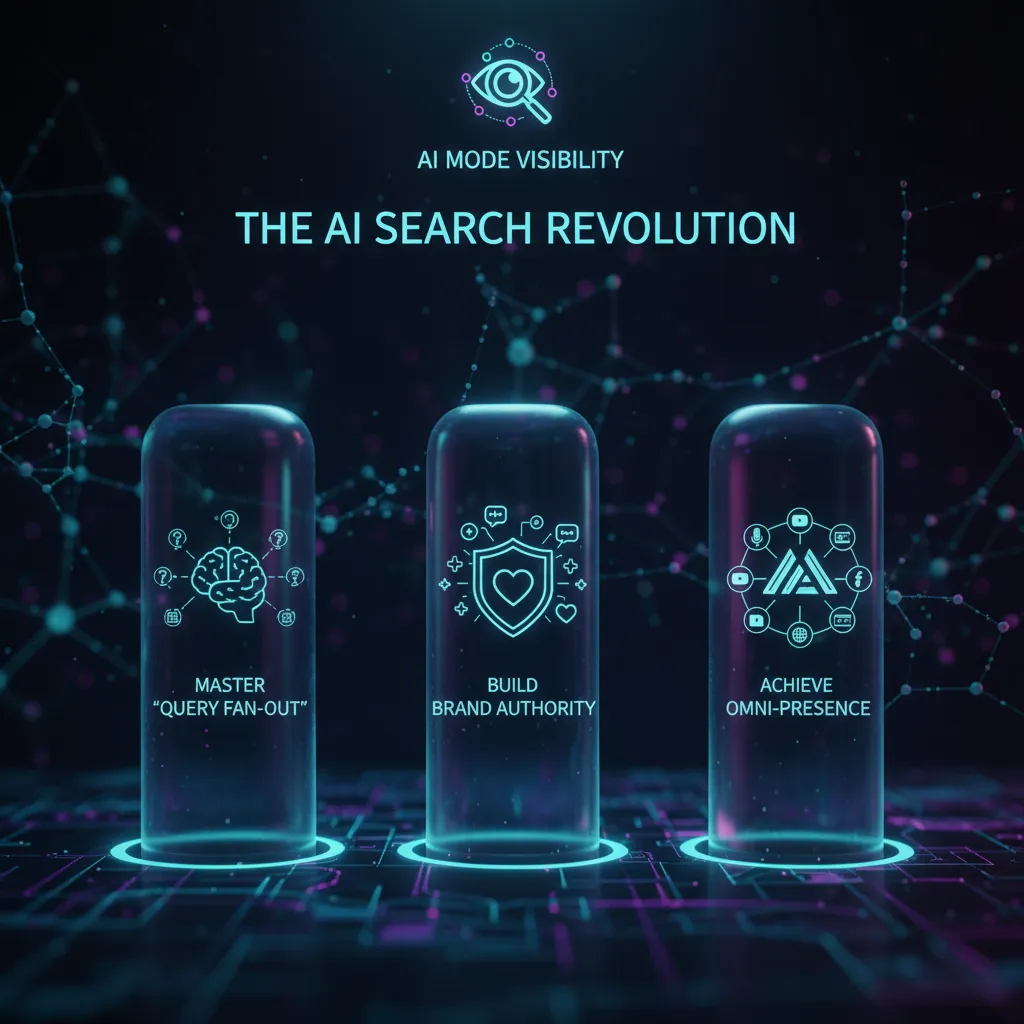
This fundamental change means our old strategies must evolve too. The question is no longer just how to rank on a results page, but how to become a trusted source for the AI itself.
Table of Contents
To succeed in this new era, you must shift your focus from chasing keywords to building a strong, authoritative brand entity. This means creating strategic content that anticipates the AI’s complex questions, securing consistent brand mentions across the web, and establishing a presence on every platform your audience uses. Google’s AI Mode prioritizes trusted entities and deep contextual relevance, and this guide will show you exactly how to become one.
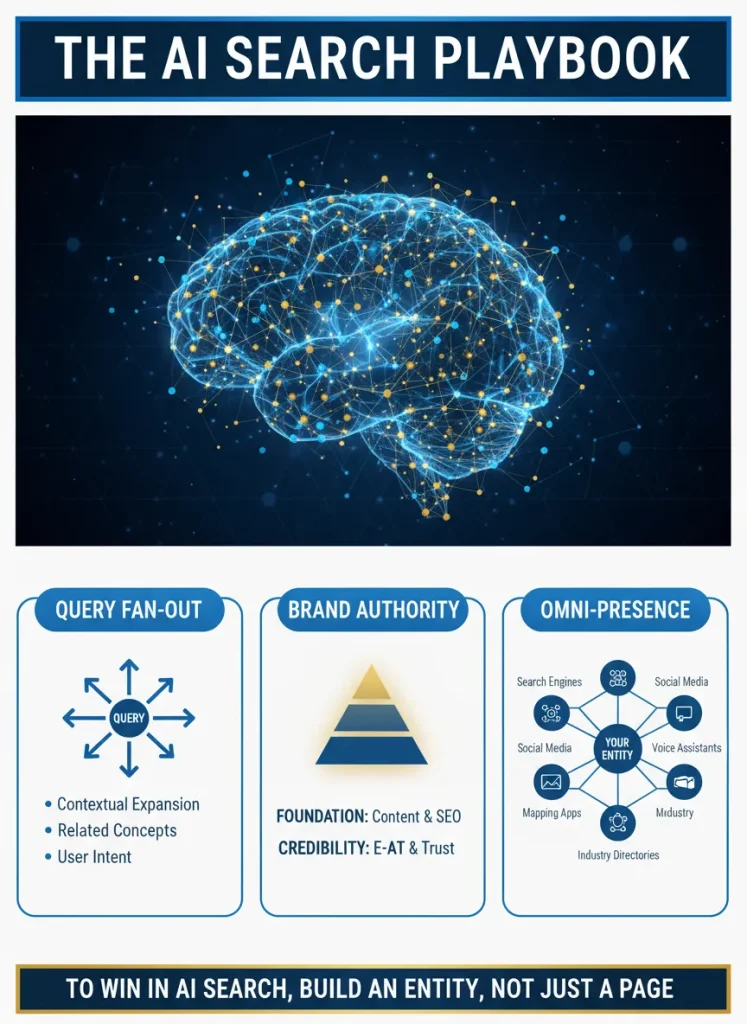
At a Glance: Key Strategies for AI Mode Visibility
- Master “Query Fan-Out”: Create a web of content that answers the multiple background questions the AI investigates for a single user query.
- Build Brand Authority: Focus on having your brand name discussed, recommended, and linked across multiple authoritative websites and platforms.
- Achieve Omni-presence: Expand your brand’s reach beyond your website to platforms like YouTube, podcasts, and influential industry forums.
- Demonstrate Credibility: Showcase your deep experience, expertise, and trustworthiness across all your digital channels to become a go-to source.
Why Traditional SEO Isn’t Enough for Google’s AI Mode

Many marketers hold the belief that a high ranking on the standard Google search engine results page (SERP) will guarantee visibility in AI Mode. While a strong SERP presence is certainly beneficial, it represents only a small piece of a much larger puzzle. The AI doesn’t just skim the top-ranking pages; it synthesizes information from a vast and diverse array of sources to construct its answers.
How is AI Mode Different from Classic Search?
Google’s AI Mode, which is powered by the Gemini model, operates on a different principle than a simple information aggregator. It isn’t just finding and presenting data. Instead, it leverages a massive, pre-trained knowledge base and then verifies, updates, and enriches that knowledge with real-time information it gathers from the web.
This sophisticated process means the AI is actively looking for specific signals of quality and authority:
- Entities: It needs to recognize your brand, your products, and your key personnel as distinct, well-defined concepts. It asks, “Is this a known and credible entity in this space?”
- Context: It analyzes how your entity relates to broader topics, user questions, and other entities. It seeks to understand your place within the larger ecosystem of your industry.
- Trust Signals: It hunts for consistent, positive mentions and discussions about your brand across the web. These signals act as third-party validation of your expertise and credibility.
Ultimately, your optimization target is no longer just a list of keywords. You are now optimizing your brand’s entire digital footprint to be recognized by the AI as a credible, authoritative, and trustworthy entity in your specific niche.
Strategy 1: Master “Query Fan-Out” with Strategic Content

When you pose a question in AI Mode, Google doesn’t simply execute one search. It initiates a “query fan-out,” a process where it breaks down your initial query into numerous, more specific background searches. It does this to gather a comprehensive and multi-faceted understanding of the topic before formulating a single, coherent answer. Understanding and strategically optimizing for this process is the first critical step toward AI Mode visibility.
What is Query Fan-Out?
Let’s say a user asks the AI, “What is the best WordPress SEO plugin?” The AI’s process is far more complex than just searching for that exact phrase. It immediately fans out, running simultaneous searches for a host of related and more granular topics to build a complete picture.
For that single query, the AI’s background investigation might include searches like:
- top-rated SEO plugins for WordPress
- Rank Math versus Yoast SEO comparison
- SEOPress features and pricing
- how to properly optimize WordPress title tags for SEO
- best schema markup plugins for WordPress sites
- lightweight WordPress SEO plugin performance benchmarks
- user reviews for All in One SEO
- how to easily migrate from Yoast to Rank Math
The AI meticulously pulls data points from the top sources for each of these distinct queries. It then synthesizes all of this information to construct a single, nuanced answer. If your content strategy only targets the primary, high-level keyword, you are effectively invisible during this crucial, in-depth investigation phase.
How Can You Uncover Hidden Query Fan-Outs?
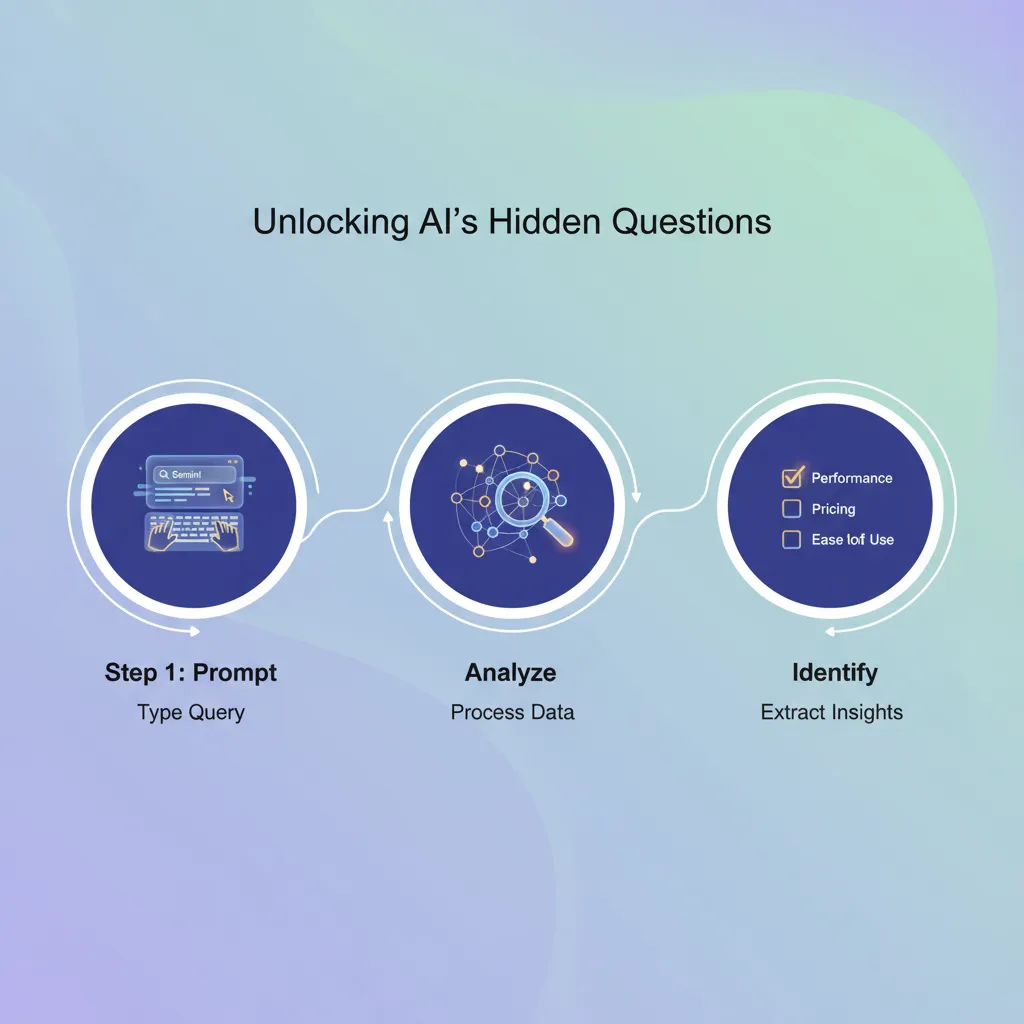
Observing the visible searches in AI Mode can provide some initial clues, but the true strategic advantage lies in uncovering the “hidden” query fan-outs. The most effective way to do this is by using Google’s Gemini platform directly and prompting it to reveal its thought process.
By asking Gemini the same question and then analyzing its detailed response, you can often find sections where it explains its reasoning. It might explicitly state that its evaluation requires finding “authoritative comparison reviews,” identifying “key differentiating factors,” analyzing “pricing models,” or looking for “technical performance benchmarks” like impact on site speed.
This insight is a strategic roadmap. It tells you precisely what the AI values. It prioritizes content that doesn’t just list features but critically compares them based on the factors that are most important to users, such as performance, ease of use, and cost.
How Do You Optimize Your Content for Fan-Out Queries?
Once you have identified these crucial fan-out queries and the underlying differentiating factors, you can begin to build a content ecosystem designed to meet the AI’s needs.
- Create Strategic Sub-Content: Avoid the trap of trying to cram everything into one monolithic “ultimate guide.” Instead, create dedicated articles, detailed landing pages, or specific documentation sections for each important fan-out query. For an SEO plugin, this would mean creating separate, in-depth posts on its Schema Markup capabilities, its impact on Site Speed, and a detailed, balanced comparison against a major competitor.
- Align with Differentiating Factors: Structure your content, and even your product’s marketing messages, around the factors the AI is actively investigating. If the AI is looking for the “most lightweight” option, your job is to provide clear benchmark data, performance tests, and case studies that prove your claim. If it’s comparing pricing, you need a transparent page that explains your value proposition in detail, especially in relation to competitors.
- Position Your Brand as the Definitive Solution: Use every piece of this sub-content to frame your brand as the ideal answer. When numerous authoritative, third-party sources all mention that your product excels in a specific area (like having the most advanced built-in schema module), Gemini perceives this as a credible, established fact. This dramatically increases the likelihood that it will feature and recommend you in its answers.
| Differentiating Factor | Content Strategy Example |
| Performance and Speed | Publish a data-driven blog post with benchmark tests: “The Real Impact of SEO Plugins on Your Website’s Core Web Vitals.” |
| Ease of Use for Beginners | Develop a comprehensive video tutorial series and create a “Getting Started: A Beginner’s Guide to Our Plugin” landing page. |
| A Specific, Unique Feature | Write an in-depth article showcasing its benefits: “How Our Advanced Schema Markup Feature Drives Higher Click-Through Rates.” |
| Pricing and Overall Value | Create a transparent “Competitor Comparison” page that honestly highlights your unique value and justifies your pricing structure. |
| The Migration Process | Produce a step-by-step guide with screenshots and video: “How to Seamlessly Migrate from [Competitor] in Under 5 Minutes.” |
Strategy 2: Build Authoritative Brand Mentions and Trust
Creating excellent content is foundational, but it is not enough on its own. For Google’s AI to confidently recommend your brand, it needs to see overwhelming, widespread proof that you are a trusted and recognized leader in your field. This is where building your brand as a distinct and authoritative entity becomes the most important part of your strategy.
Why Your Brand Entity is the New Backlink
According to extensive research from industry leaders like Ahrefs, the single factor with the strongest correlation to visibility in AI-generated answers is the volume of branded web mentions. The more frequently your brand name appears alongside your core topics on other authoritative websites, the more Google’s AI recognizes you as a key, credible player in that space.
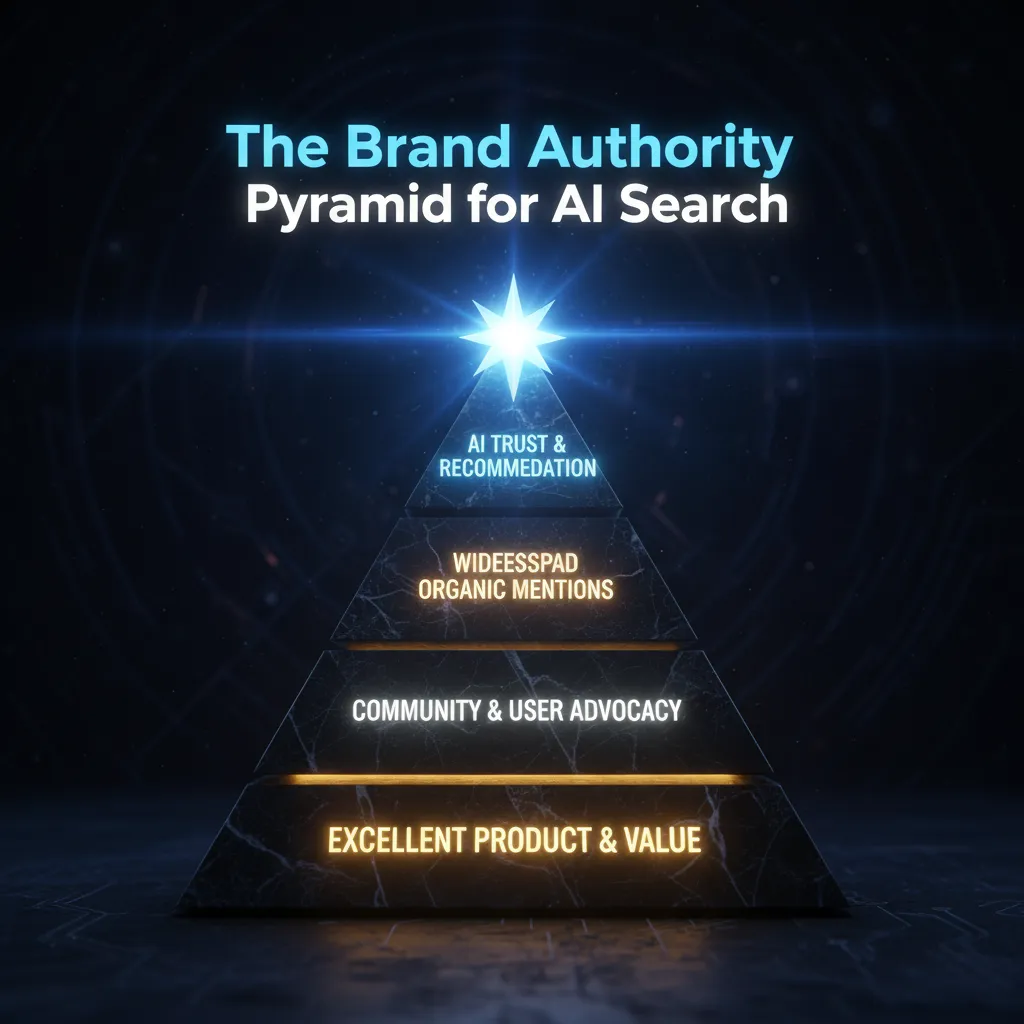
However, this is a signal that cannot be easily faked or manipulated. The absolute foundation of this strategy is having a product or service that is genuinely excellent. If your offering provides immense value and solves a real problem for users, they will naturally talk about it. They will recommend it in forums, discuss it on social media, and feature it in their own content. This organic advocacy creates a powerful community and a bedrock of trust. No amount of marketing spend can sustainably prop up a brand built on a poor product.
What is a Three-Phase Approach to Building Brand Authority?
If your brand is new to the market or is looking to solidify its position as a leading entity, following a structured, three-phase approach can build momentum and create lasting authority.
Phase 1: Establish Your Foundation and Positioning
Before you can effectively ask others to talk about you, you must have an unshakeable and crystal-clear understanding of who you are and what you stand for.
- Define Your Unique Positioning: What is the one thing you want to be known for? Are you the most affordable option, the highest-quality premium choice, the simplest solution for beginners, or the only tool that solves a very specific, niche problem? This positioning must be clear, compelling, and consistent across every single piece of your messaging.
- Build a Helpful Website Hub: Your website should be more than a digital brochure; it should be a comprehensive resource hub. Fill it with genuinely helpful content that supports your product, answers common questions, and solves user problems. This practice naturally fuels valuable branded searches in the long run (e.g., “YourBrand schema markup tutorial”).
- Create a Professional Press Kit: Make it incredibly easy for journalists, bloggers, and partners to feature you correctly. A simple, accessible press kit should include a concise business description, high-resolution logos, a brief founder bio, and other essential, downloadable assets.
Phase 2: Execute Strategic Outreach (The “Push” Technique)
Once your foundation is solid, you must actively seek out opportunities to be featured on established, authoritative platforms that are relevant to your industry but are not direct competitors.
- Identify High-Value Targets: Compile a list of respected industry publications, influential news outlets, and well-regarded niche blogs whose audiences align with yours.
- Offer Genuine Value: Do not simply ask for a mention or a backlink. That approach is outdated and ineffective. Instead, offer something genuinely useful to them and their audience. This could be unique data from a recent case study, expert commentary on a trending industry topic, or a high-value guest post that solves a real problem for their readers.
Phase 3: Amplify Your Reach and Encourage Mentions (The “Pull” Technique)
The final phase is about creating an environment where people want to talk about your brand organically. This involves building a vibrant community and generating authentic buzz.
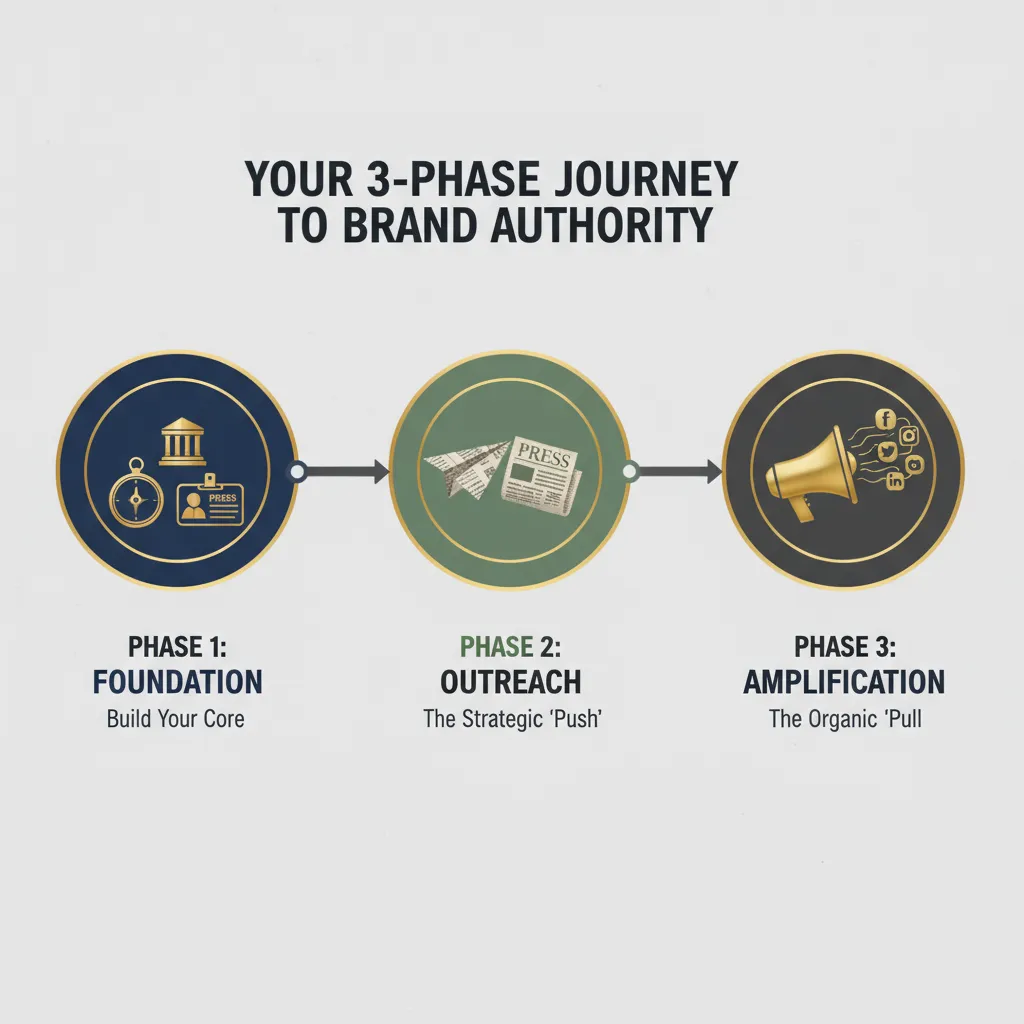
- Foster a Thriving Community: Create a dedicated space, like a Facebook group, a Slack channel, or a private forum, where your users can connect, share tips, and help each other. An active community is a powerful source of organic mentions.
- Incentivize User-Generated Content: Run contests, offer rewards, or create affiliate programs that encourage users to create their own content, tutorials, or reviews featuring your product. This strategy generates a consistent stream of authentic mentions and social proof.
Strategy 3: Achieve Omni-presence Across Multiple Platforms
To be perceived as a true authority by Google’s AI, your expertise cannot be confined to the pages of your own website. You must consistently demonstrate your knowledge and value across the entire digital ecosystem where your target audience spends their time. This is the essence of becoming omnipresent.
Why You Need to Look Beyond Your Website
The data is clear: the sources cited in AI Overviews and AI Mode are incredibly diverse. One internal study found that a YouTube video was cited as a primary source in AI Overviews approximately 65% of the time. This is a massive signal that Google’s AI values, trusts, and prioritizes video content as a rich source of expert information.
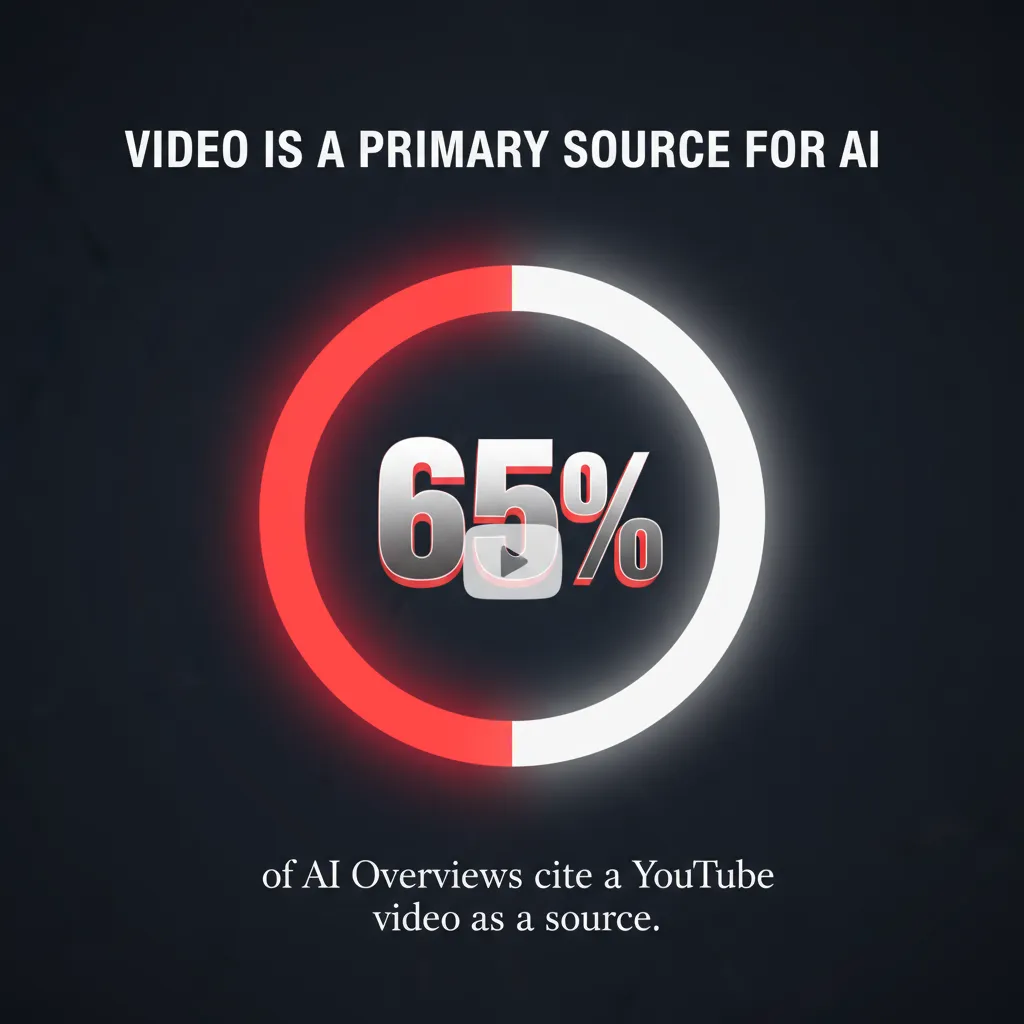
Furthermore, the AI is not limited to websites and videos. It can and will pull information directly from other platforms if a user’s query requires it. For example, a search for “the best Facebook groups for learning about AI” will yield results sourced directly from Facebook’s platform. This is definitive proof that the AI’s scope of investigation extends far beyond traditional web pages.
Which Platforms Should You Focus On?
Your primary goal is to build strong signals of credibility, experience, and expertise everywhere you appear. Your strategy should be tailored to the platforms that are most relevant to your audience and your industry.
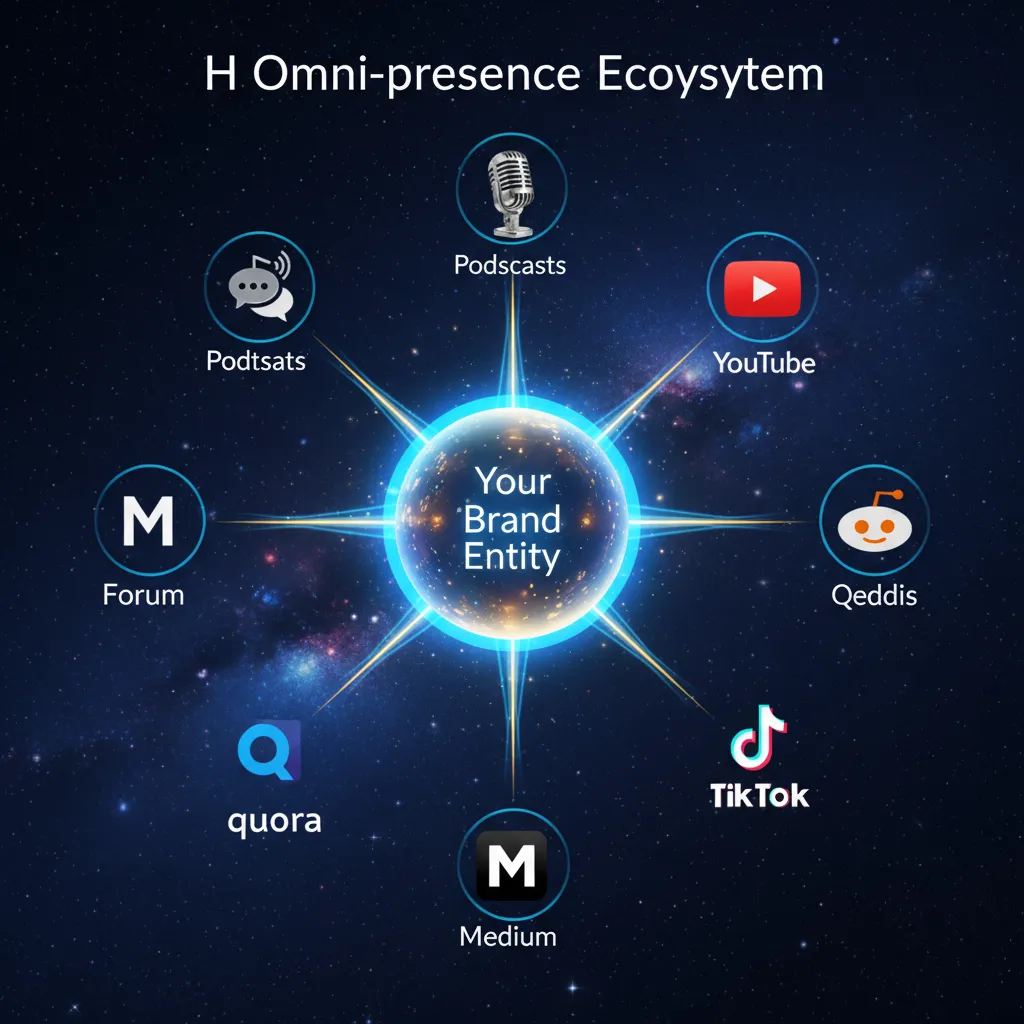
- Video Platforms: A presence on YouTube, TikTok, and Instagram Reels is now non-negotiable for most brands. These platforms are perfect for demonstrating expertise through detailed tutorials, product explainers, customer case studies, and industry analysis.
- Audio Platforms: Hosting or appearing on podcasts allows for long-form, nuanced discussions that are perfect for establishing deep authority and thought leadership on complex topics.
- Public Forums: Actively and helpfully participating in communities on Reddit, Quora, and other industry-specific forums showcases your expertise in a public, verifiable, and community-oriented way.
- Publishing Platforms: Sharing valuable insights and articles on platforms like Medium and LinkedIn helps build both your personal and your corporate brand authority.
How Can You Leverage Paid Media for Brand Positioning?
Achieving true omni-presence isn’t just about creating organic content. Strategic advertising and sponsorships play a crucial role in reinforcing your brand positioning at scale. The goal of these paid campaigns isn’t just to generate immediate clicks; it’s to send a clear, consistent, and memorable message about what your brand stands for.
Think of how iconic brands have used positioning for decades:
- KFC: “Finger Lickin’ Good” immediately communicates taste and satisfaction.
- Subway: “Eat Fresh” positions the brand as a healthier, customizable fast-food alternative.
- Domino’s Pizza: The famous “30 minutes or it’s free” promise was all about speed and reliability.
Your paid campaigns should relentlessly hammer home your unique positioning. Modern avenues for achieving this include:
- Creator Sponsorships: Partner with trusted YouTubers, podcasters, and influencers in your niche to have them talk about your brand in an authentic way.
- Affiliate Programs: Empower a wide network of content creators to recommend your product across any channel they choose, dramatically multiplying your brand’s exposure and reach.
- Platform Advertising: Run highly targeted ad campaigns on YouTube, TikTok, Facebook, Reddit, and Twitter that are designed to reinforce your core brand message and unique value proposition.
Putting It All Together: Your Action Plan for AI Mode Dominance
Succeeding in Google’s AI Mode is a long-term commitment that rewards the development of a genuine, valuable, and widely-recognized brand. The era of finding simple SEO loopholes is drawing to a close; the future belongs to those who build undeniable authority.
Your action plan is clear and straightforward:
- Analyze and Deconstruct: Use tools like Gemini to reverse-engineer the “query fan-outs” that are most relevant to your core topics and products.
- Create and Conquer: Build a comprehensive content ecosystem composed of strategic sub-content that directly addresses every facet of the AI’s deep investigation process.
- Build and Amplify: Focus relentlessly on building a superior product and use a phased, strategic approach to generate authoritative brand mentions across the entire web.
- Expand and Be Everywhere: Establish a strong omni-channel presence, with a special emphasis on video platforms, and use paid media to solidify and scale your unique brand positioning.
By embracing this holistic, brand-first approach, you will not just be optimizing for a new algorithm. You will be building a resilient, respected, and authoritative brand that Google’s AI will trust and recommend for years to come.
Frequently Asked Questions (FAQs)
What is Google’s AI Mode?
Google’s AI Mode is an interactive, chat-based feature within Google Search that is powered by the Gemini model. It allows users to ask follow-up questions and “dive deeper” into a topic after an initial search. It provides conversational, synthesized answers that are drawn from a wide range of web sources.
Is ranking in AI Mode the same as regular Google search?
No, it is fundamentally different. While there is some overlap, ranking in AI Mode is less dependent on traditional on-page SEO factors and more reliant on your brand’s overall authority, its trust signals, and the consistency of its mentions across multiple platforms. The AI synthesizes information to create an answer rather than just ranking a list of individual pages.
How important are backlinks for Google’s AI Mode?
While backlinks continue to be a signal of authority, their role is evolving. In the context of AI Mode, a direct brand mention, which is your brand name appearing on an authoritative site even without a hyperlink, can be just as, if not more, powerful. The AI’s focus is on entity recognition and understanding the contextual association between your brand and your topics.
Should I focus on creating content or building my brand?
You must do both, as they are two sides of the same coin. Your content serves as the primary vehicle for demonstrating your expertise and communicating your brand’s unique positioning. Your brand-building efforts, including outreach, community management, and sponsorships, create the powerful trust signals that cause the AI to recognize and recommend your content.
What is the most important platform for AI Mode visibility besides my website?
Based on current data and trends, YouTube is arguably the most critical complementary platform. Video content is very frequently cited in AI-generated answers and is an exceptionally powerful medium for demonstrating experience, expertise, and authority, which are all core components of the AI’s evaluation process.








